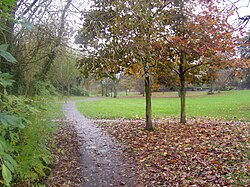Prince's Park, Liverpool
| Princes Park | |
|---|---|
 | |
 | |
| Type | Public Park |
| Location | Liverpool, England, UK |
| Coordinates | 53°23′10″N 2°57′14″W / 53.386°N 2.954°W |
| Area | 111.197 acres (450,000 m2) |
| Operated by | Liverpool City Council |
| Status | Open all year |

Princes Park in Toxteth, Liverpool, England, is a 45 hectare municipal park, 2 miles south east of Liverpool city centre. In 2009 it had it status upgraded to a Grade II* Historic Park by English Heritage.
The park was originally a private development (though open to the public) by Richard Vaughan Yates, the cost of which was expected to be met through the development of grand Georgian-style housing around the park.
In 1918 the park was acquired by Liverpool City Council.
Princes Park was designed by Joseph Paxton and James Pennethorne and opened in 1842. The plan was drawn by John Robertson and Edward Milner supervised the work. The original gates can still be seen. With its serpentine lake and a circular carriage drive, the park set a style which was to be widely emulated in Victorian urban development, most notably by Paxton himself on a larger scale at Birkenhead Park. Princes Park also influenced its near neighbour, Sefton Park.
An obelisk and former drinking fountain in the park bears the inscription:
- To the memory of Richard Vaughan Yates
- The enlightened & philanthropic founder of Princes Park
- Erected by public subscription 1858
Within the park is also a gravestone, dated 1926, in memory of a donkey called Judy who gave "21 years of service", providing rides for children in the park. The Doric Lodge, which was situated by the Sunburst Gates at the main entrance, was destroyed by bombs in 1940.
There is a lake in the middle of the park, originally for boating, which is used today by fishermen. The foundations of its formerly Grade II listed boathouse, which burnt down in the early 1990s, can still be seen at the south end.
Grade II* Historic Park
In 2009 the Park had it status upgraded to a Grade II* Historic Park by English Heritage, making it one of three such parks in the city, along with Sefton Park and Anfield Cemetery. English Heritage gave four reasons for upgrading the park's status. These were that it was the first major park created by Paxton, and that it inspired other designers, who incorporated elements of the park in other urban parks throughout the United Kingdom. In addition, the original look of the park is still intact and it is also an important example of a green haven in a city setting.
parkrun
Princes Park is now host to a weekly, free and timed 5k running event as part of the parkrun uk organisation. The event is based in the centre of the park and starts at 9am every Saturday. It regularly attracts over 100 runners from the local area who enjoy running the course, taking in the whole park. For more information, check out www.parkrun.org.uk/princes/
External links
- Liverpool City Council Parks and Gardens
- Richard Vaughan Yates Obelisk Drinking Fountain
- http://www.gardenvisit.com/g/pri3.htm
- Aerial Photo
www.parkrun.org.uk/princes
